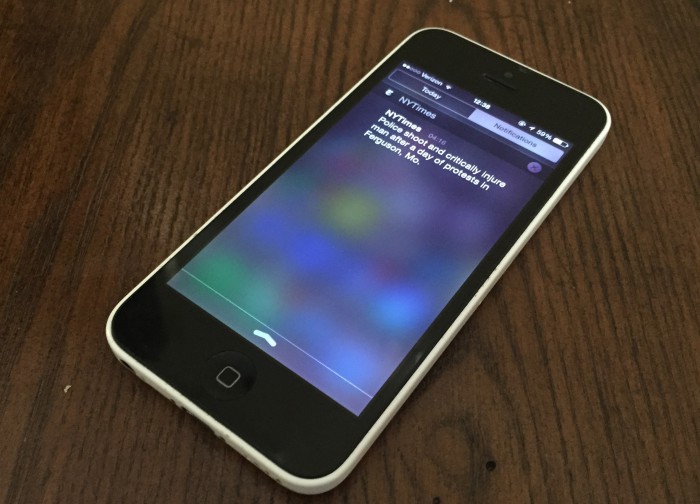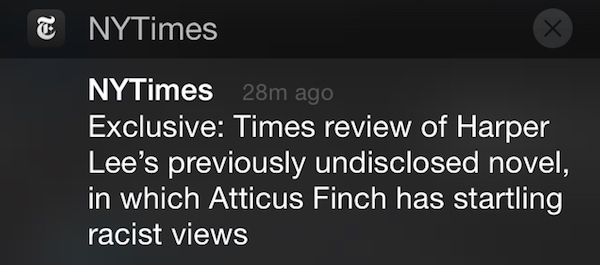
Editor’s note: This is the first in a series of stories on how news organizations manage their mobile news alerts. Check in each day this week to see how The New York Times, CNN, Breaking News, The Wall Street Journal, and the Detroit Free Press decide which news warrants a push notification, and learn about the process each goes through to send alerts out to their readers. First up: the Times.
All it took was one push alert for The New York Times to forever alter how Atticus Finch, one of the United States’ canonical literary figures, is perceived.

Though the Times covered the revelations about Atticus Finch in Harper Lee’s “new” novel Go Set a Watchman on the front page of the print editions on Saturday July 11 and Sunday July 12, it’s not too farfetched to argue that the mobile notification had more of an impact than the stories on A1.
The New York Times alert that ruined my childhood. #atticusno pic.twitter.com/0sLPwhV2MU
— Claire Fishman (@ClaireFishman) July 11, 2015
Uh spoiler much @nytimes?
— Maira Garcia (@mairalg) July 10, 2015
“We send a push notification. The phone beeps, buzzes, vibrates, lights up and there’s a message on a locked home screen,” New York Times assistant editor Clifford Levy told me. “It allows us to, for all intents and purposes, tap the user on her shoulder. That’s very, very powerful.”
I spoke with day editor Karron Skog, who described the processes the Times goes through and what it considers before sending out an alert. Here, lightly edited and condensed, is what Skog had to say:
Around two years ago, we sent mobile alerts without linking to anything. We did a little research and found out that this was really frustrating for people. They would come to alerts not linking to anything and many of them would not come back. A large percentage of people would never check back to see if we had posted a story about it.
We decided that we needed to link to a stub of an article, but it’s been very tricky to get the different desks to understand exactly what that means. We don’t need a full article, we don’t need 700 words; we need three sentences. We’ve gone through different stages of training and protocol with the desks. We talk about exactly what the process should be when we want to send a news alert, so we can try to get things out faster and faster. It’s gone pretty well. We still have some blips here and there, where we have a reporter who may want to file more and the editor isn’t aggressive enough to say, ‘We don’t need that much. Just send us the bare minimum of what you have and you can fill out from there.’It’s been a process to train editors’ and reporters’ brains that this isn’t print. You can go back as many times as you want and add in extra grafs. But we’ve gotten pretty good at getting these three sentences out.
Maybe six months ago, we started to work on what we call the middle game. We got good at getting out the news alerts when news broke, but then the stub of the story would sit there with three sentences for an hour or two hours. We have been trying to work on getting them to file in chunks, because that next hour [after the alert] is really crucial to getting readers back to us.
We wrestle with ourselves about this on the news desk. We may feel like we’re late on an alert, or maybe we’re not even late, maybe we just waited longer than other news organizations because we had an extra detail that we wanted to add. We’ll have this debate: Should we alert it now? It seems late, but readers aren’t staring at their phones and checking their alerts constantly the way we are. People might come to it an hour from now, or it might be three hours from now. If they do, they’ll find an updated story. That stub of an article keeps refreshing with everything new. So we feel that it’s worth it, even if we’re going to be a little late. The desks don’t individually send alerts, but they suggest them. They file their three sentences, it goes to an editor, sometimes it will go through a copy editor. Usually we can send those three sentences through pretty quickly with about three sets of eyes on them. We use Slack for our messaging system, so we might be Slacking each other back and forth different possibilities for the alert language. The homepage producer technically, physically, sends the news alert. They can send an email alert and an alert to Twitter at the same time.
We make those kinds of choices all the time: Should we just send an email alert? We try to stay away from alerting things between 11 p.m. and 6 a.m. Eastern time unless it’s major, major breaking news. This morning, we alerted the Greek debt crisis deal at 3:30 in the morning. When the South Carolina legislature voted in the middle night [to remove the Confederate flag], whoever was on duty at the time decided that it was the middle of the night and we weren’t going to alert it, but it still should’ve been an email alert. We have a scale, with the mobile push being the most important. Email is for news that we think our readers are going to be interested in, but it’s not necessary to interrupt whatever they’re doing.
We have editors in Hong Kong and London who staff overnight in the New York hours. The business desk in London has been handling the Greek crisis and has been manning our liveblog, deciding when to send news alerts. I get in at 6 a.m., and they are the first people I talk to in the morning to find out what’s happened overnight. They know our protocol about not sending alerts during U.S. sleeping hours. They know that most of our subscribers are in the United States, and in that case they might do an email alert or do a homepage alert to let readers in their time zone know what’s going on, while not disturbing readers in the United States.We also have a lot of discussion about [alerting for feature stories or exclusives]. We’re mindful of the fact that it may irritate our readers when they get alerts about things that aren’t breaking news. We’ve been very careful about how we craft the wording for those things and how many of them we do. The Harper Lee one was a no-brainer because because all the coverage we’d done of it so far had been wildly popular.
We do a lot of alerts on the weekends for our big enterprise stories. We try to word the alert so it has some urgency to it. Early on, we had a couple that bombed.
Just got a NYT breaking news alert that just reads "The Avalanche at Tunnel Creek." Should I expect a Steinbeck short story?
— Christopher Hooks (@cd_hooks) December 20, 2012
Dear @NYTimes, why did you sent this as a breaking news alert on your mobile app? Tsk tsk! http://t.co/KHJatbLM
— Myra Kohn (@bonnevivante) December 20, 2012
We’ve tried really hard to think about whether something is really worth alerting. Is it something we’ve put a lot of time into, that Times readers are going to want to know is out there? And can we do it in a way that lets people know why we’re doing it?